
Street light poles refer to the poles used to install street lamps, known as light poles. They can be divided into iron road light poles, stainless steel road light poles, aluminum alloy road light poles, and so on. Street light poles are mainly suitable for roads, communities, scenic spots and residential areas.
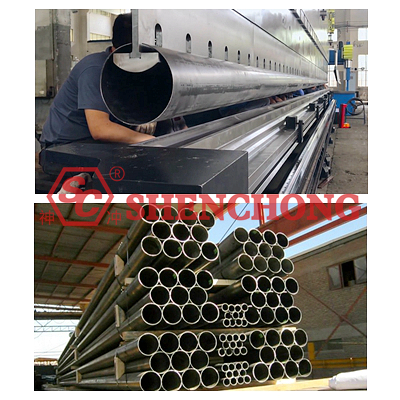
The illumination level of street light poles affects the appearance and physical factors of the urban night landscape, and more importantly, it lies in the behavior place and driving safety.
The setting of lampposts is reasonable, the lighting environment is suitable, and the urban activity is strong. If the safety of street light poles is not high, citizens will inevitably reduce the number of outdoor activities at night, and the urban night landscape will become dull.
The role of street light poles in urban landscapes is self-evident, with a dual landscape effect of day and night. Its lighting performance must be stable to ensure the safety of vehicle and pedestrian activities at night and reduce the occurrence of traffic accidents and criminal incidents.
With the increasing demand for street lighting, the market for its supporting products, street light poles, is also becoming increasingly large.
But you know what? In fact, there are different classifications of lampposts, and the materials used for street light poles also vary. According to the different materials used for street light poles, they can be divided into the following 5 categories.
Aluminum alloy street lamp poles are made of high-strength aluminum alloy. The manufacturer not only humanizes the protection of personnel safety, but also has high strength and corrosion resistance for over 50 years without any surface treatment.
They are also very beautiful and look more high-end. Aluminum alloy has better physical and mechanical properties than pure aluminum: easy to process, high durability, wide application range, good decorative effect, rich colors, and so on. Most of this street light pole is sold overseas, especially in developed countries.
Stainless steel lamp poles have better chemical and electrochemical corrosion resistance in steel, second only to titanium alloys. The method adopted in our country is to carry out surface treatment with hot-dip galvanizing, and products that meet international standards with hot-dip galvanizing can have a lifespan of up to 15 years.
Heat resistance, high temperature resistance, low temperature resistance, and even ultra-low temperature resistance. Most of them are used in courtyards, residential areas, parks, and other places.
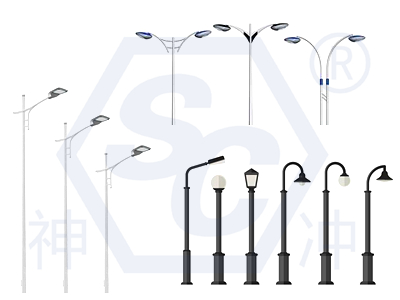
Cement road light poles are attached to urban power towers or erected separately due to their bulkiness, high transportation costs, and danger. The market is now gradually phasing out this type of road light pole.
Iron street lamp pole, also known as high-quality Q235 steel pole. Made of high-quality Q235 steel coil, hot-dip galvanized and sprayed with plastic, it can withstand 30 years of corrosion and is very hard. This is the most common and commonly used street lamp pole in the street lamp market.
Fiberglass lamp poles are a high-performance inorganic non-metallic material with a wide variety of advantages, such as good insulation, strong heat resistance, good corrosion resistance, and high mechanical strength. However, their disadvantages are brittleness and poor wear resistance. So, not many are used in the market.
Because the quality of the material of the street lamp pole will directly affect the service life of the street lamp pole. So it is recommended to pay attention to whether the material selection is suitable when selecting street light poles (based on the climate and geographical environment of the region).
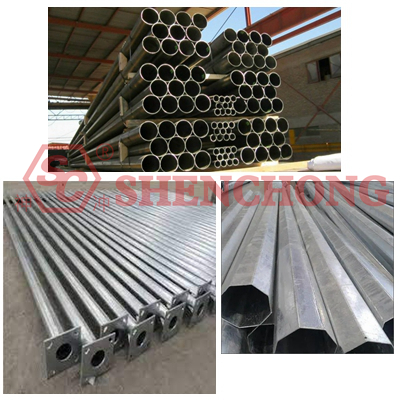
Based on the above introduction, we have a basic understanding of the different types of street lamp poles. Next, we will focus on introducing the production and manufacturing process of commonly used street lamp poles, as well as the production equipment used in the production process.
The rolling shear machine cuts the material into trapezoidal shapes. The materials used in this process may vary depending on the customer's requirements.
Before cutting, first adjust the slope of the longitudinal shear machine to match the required size of the longitudinal shear, and determine the position of the steel plate to ensure the maximum size of the remaining material, so that the remaining material can be utilized.
Before opening the material, it is necessary to check the operation of the roller shear equipment, clear the debris on the track, and maintain the equipment in good working condition.
The length of trapezoidal materials is produced and manufactured according to customer requirements. Due to the different thicknesses of materials used, the size of the selected bending machine will also vary, ranging from 160 tons to 600 tons, with lengths ranging from 12 meters to 14 meters, and even longer ones can reach 16 meters.
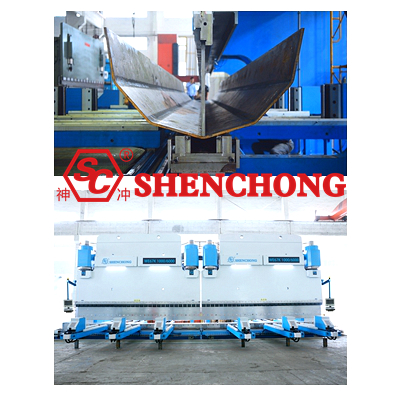
Usually, a tandem press brake bending machine is used to bend the customized bending mold into the desired cylindrical shape for customers.
Bending is the most critical process in lamp pole production, and the quality of bending directly affects the quality of the lamp pole, and it cannot be repaired after bending. So choosing a suitable press brake machine manufacturer is very important.
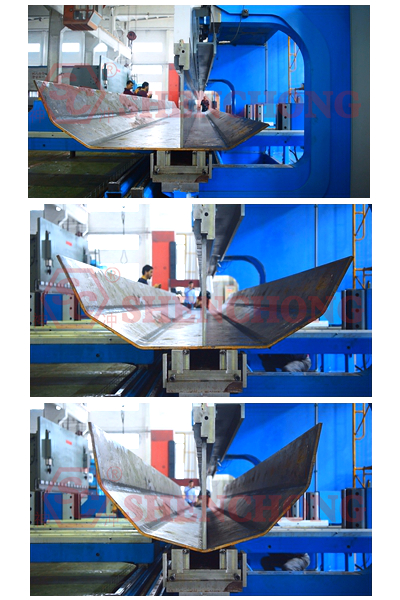
Wuxi Shenchong has been specializing in the production of CNC press brake machines for 20 years, with rich production experience. We provide professional customized production services tailored to the requirements of different users, including the needs of street lamp pole manufacturers, which can be fully met. You can contact us for consultation at any time about the CNC press brakes, shearing machines & rolling machines.
Perform straight seam welding on the bent pipe seam. Due to the fact that welding is an automatic buried welding, it is mainly because the welder should have a greater sense of responsibility and pay attention to adjusting the welding position during welding to ensure the straightness of the weld seam.
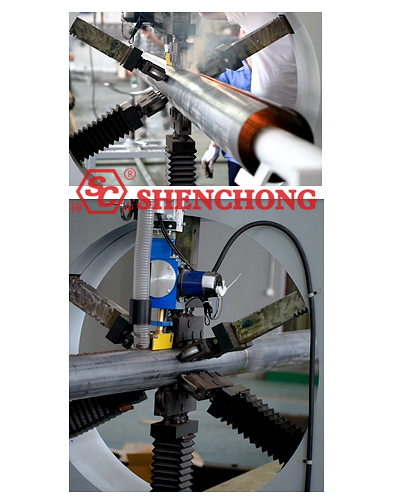
Because the pipes will deform to a certain extent after welding, they must be reshaped and straightened mechanically. According to the customer's production process requirements for street lights, it may also be necessary to bend the pole body to a certain angle.
Grind with a grinder. This process is optional and can be completed manually. But if it is a large-scale production of street lamp poles, it is recommended to use mechanical operations, which can save labor costs and time costs.
The end trimming process is to flatten both ends of the completed pipe body to ensure that the pipe mouth is perpendicular to the centerline, without any unevenness in angle or height. At the same time, after flattening, the end face is polished.
The quality of galvanizing directly affects the quality of the lamp pole. Galvanizing is required to be carried out in accordance with national standards, and the surface after galvanizing is smooth without color difference and free from sagging. Lamp poles with severe sagging must be repainted.
This process mainly involves the automatic spraying of street light poles through the spraying production line. The main purpose of spray molding is for aesthetics and corrosion prevention. Firstly, the surface of the galvanized lamp pole should be polished with a polishing wheel to ensure a smooth and flat surface. Then straighten the polished light pole, align the pole mouth, and ensure that the straightness of the pole is above 99%. The caliber deviation requirements are: small pole ≤ ± 1mm, large pole ≤ ± 2mm. Subsequently, it is sent to the spraying room and sprayed according to the color required by the customer. Finally, it is sent to the drying room. The temperature and insulation time of the drying room must strictly comply with the requirements of each plastic powder to ensure the adhesion and smoothness of the plastic powder.
After all the above street light pole production processes are completed, inspection and packaging are completed, and the final product can be shipped.
Case show:
Street Light Pole Production Line: uncoiling, leveling, bending, and welding